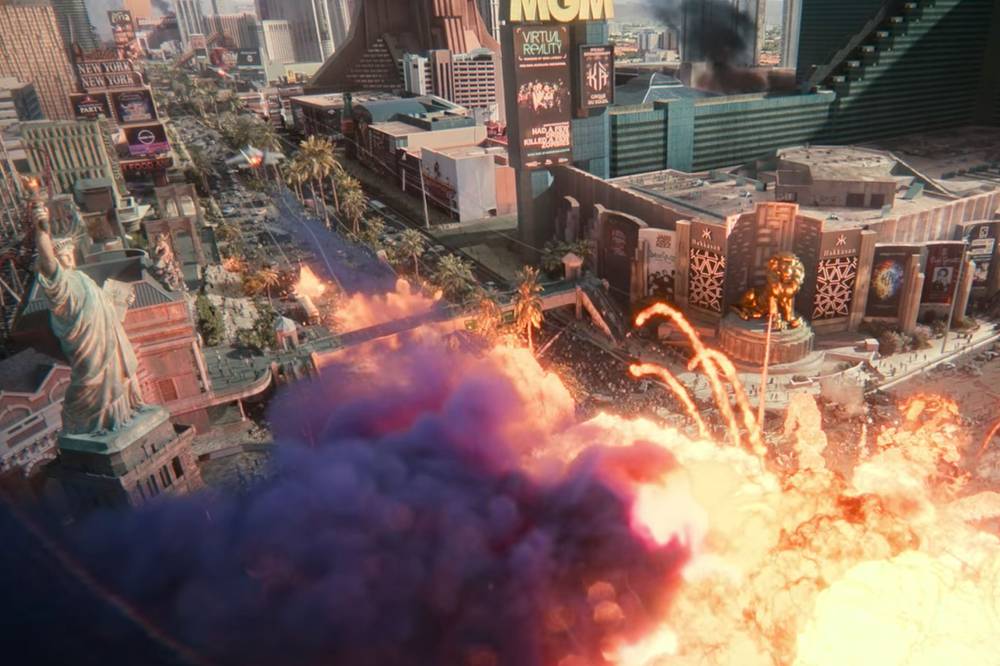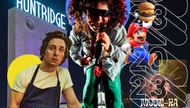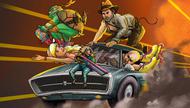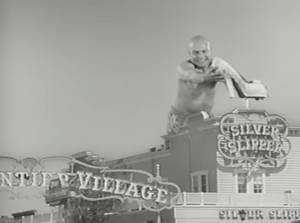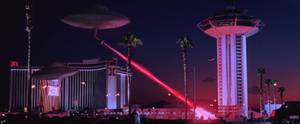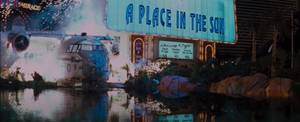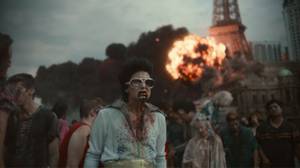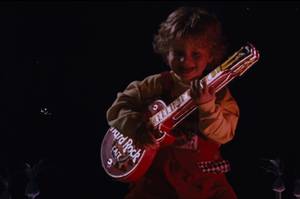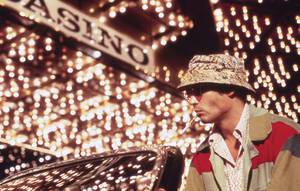Las Vegas was still relatively young when Hollywood decided to destroy it. In the 1957 Bert I. Gordon movie The Amazing Colossal Man, a soldier, mutated by atomic fallout into a 60-foot giant, stumbles into our tourist corridor and trashes it. Initially curious—he leers at a bathing woman through a hotel window, lifts the crown off the roof of the Royal Nevada and snatches up the Silver Slipper’s giant, high-heeled namesake—he eventually turns violent, smashing the Sands’ sign and cleaving Vegas Vic in two. Bored with demolition, he stomps off to the Hoover Dam, where some well-meaning friends jab him with an antidote in a hypodermic needle the size of a surfboard, and an errant bazooka shot sends him tumbling into the Colorado River.
You really needn’t watch The Amazing Colossal Man yourself; it’s not as fun as it sounds. (All the great B-movie stuff—including the Vegas sequence—comes late in the picture. If you must, watch the Mystery Science Theater 3000 version, available on YouTube.) But the movie is a watershed: it began a 64-year tradition of genre movies and television shows destroying Las Vegas for kicks, continuing through this summer’s Zack Snyder-directed thriller Army of the Dead. The cause of our downfall is usually nuclear holocaust, natural disaster or zombie apocalypse … and sometimes, when we’re lucky, the occasional giant.
We generally don’t ask why Vegas is destroyed in these movies, if we end up seeing many of them at all. (There will be several mentioned in this piece that I’d never even heard of before I began looking for them.) We tend to focus on errors of geography, like when 2007’s Resident Evil: Extinction omits the Excalibur from its version of the Strip, or continuity, like the climactic chase of 2016’s Jason Bourne, which jumps nearly 2 miles—from Bally’s to the Riviera—in less than a second. But things are different now. In the past 20 years, our Valley has endured several potentially apocalyptic real events, from the economic ruin of the 2008 recession to the horrific mass shooting of October 1, 2017. Hollywood might not consider the psychological cost of “wrecking” Las Vegas again and again, but we ought to.
In all fairness, Hollywood is equally game to wreck New York City (Watchmen, Deep Impact), Washington, D.C., (Independence Day, Superman II) and even itself (Volcano, San Andreas). But the tone of these destructive scenes is more somber, more reverent. The destruction of Washington, D.C., is an easy stand-in for the fall of democracy, while the destruction of New York City embodies the decline of America’s cultural and economic strength. (LA disaster movies feel like wish fulfillment for the people who live and work there—no more sprawl, traffic or wildfires, just rolling hills and newly vacant oceanfront property). By comparison, the destruction of Las Vegas is oftentimes mean-spirited or played for laughs—as if we had it coming.
The easiest assumption is that, for whatever reason, the entertainment industry doesn’t like Vegas much, despite using the city for its industry conventions and harebrained celebrity dining concepts. (Google “Steven Spielberg’s Dive.” I’ll wait.) Perhaps our city disgusts them as it did Terry Gilliam, who shot 1998’s Fear and Loathing in Las Vegas here: “Vegas just may be the perfect reflection of America at this stage in its history. It’s turning into Disneyland, and everybody’s becoming these mindless infants who wander around and don’t do anything,” he said in a May 1998 interview with the Las Vegas Sun, going on to denigrate the look of the Strip (it has the “overriding sadness of desperation”) and the people who frequent it (its women are “bloated, inverted pear shapes”; its men “little pinheads” who “walk like there’s something stuck up their ass”). Perhaps unnecessarily, Gilliam concluded the interview by saying “Anyone stuck in Las Vegas needs all the help they can get.”
And there it is: To filmmakers like Gilliam, Las Vegas is American laziness, promiscuousness and idiocy writ large. It’s like we’re the first victim in a horror movie—the drunk, horny idiot who unwittingly strays into a comically gruesome death. Half the time, the rest of the community doesn’t even realize or believe that person is gone; things won’t begin to get real until someone “upstanding” is diced, incinerated or eaten. In 1996’s Mars Attacks!, 1997’s Con Air and the 2006 CBS limited series Category 6: Day of Destruction, Las Vegas continues to gamble, drink and screw even as it’s ripped apart. Contrasted against the numbing, horrific events of 10/1—and our community’s immense, focused humanitarian response to it—the giggling half-wit stereotypes of Category 6 aren’t just insulting, but provably wrong.
That isn’t to say that I don’t occasionally enjoy watching this town destroyed in some goofy way. We’ve been vaporized, zombified, Sharknado’d. And like all persistent trends in popular art, if you look at this let’s-destroy-Vegas thing long enough and in the right way, it’ll explain why it keeps happening over and over again.
Party at Ground Zero
The Amazing Colossal Man belonged a streak of 1950s B-movie giants, both human (1958’s Attack of the 50 Foot Woman, a superior film to Colossal in every way) and insect (the giant irradiated ants of 1954’s Them!). And while Colossal is the only one explicitly set in Nevada, they all belong to the same public anxiety: From 1951 to 1962, atomic bombs were being detonated into the atmosphere at the Nevada Test Site, only 65 miles northwest of Las Vegas. And Vegas’ casinos took full advantage of the spectacle, hosting watch parties and serving atomic bomb-themed cocktails. People watching the blasts, either in person or on television, must have idly wondered: Just what is this gonna do to me?
Nearly 60 years on, the cultural fallout of the Nevada Test Site lingers. One of the city’s oldest continually operating bars is Downtown’s Atomic Liquors. (Martin Scorsese snuck it into 1995’s Casino.) One of Vegas’ most often-reprinted classic images is “Miss Atomic Bomb,” a 1957 Don English photo of Copa Room showgirl Lee Merlin set against a billowing mushroom cloud; The Killers took the name for a 2012 single. And even as recently as 2017’s Blade Runner 2049, Las Vegas has been depicted on film as patient zero of a nuclear holocaust.
Some movies hit you over the head with it. Roger Zelazny’s Damnation Alley (1977)—a crappy but watchable sci-fi road movie starring George Peppard, Jan-Michael Vincent and the coolest recreational vehicle you’ve ever seen—depicts post-apocalyptic Vegas as half-buried in sand, with Circus Circus as its only intact property. Vincent’s character tosses off a dismissive eulogy: “It always looked better at night. By day, it looked like Barstow with high-rises.” Resident Evil: Extinction draws from the same playbook, with one of its zombie battles set on the half-buried towers and bridges of the Venetian.
Notable is Gareth Edwards’ 2014 reimagining of Godzilla, the biggest and best of the atomic-age radiation monsters. In a brief but spectacular sequence, an immense, spider-legged “MUTO” (“Massive Unidentified Terrestrial Organism”) escapes from a vault in Yucca Mountain and stampedes through Vegas, destroying the Strip in an almost desultory manner as it passes through. If there’s a more potent metaphor for the dangers of storing nuclear waste at the Yucca facility, I’ve yet to see it.
And then there’s The Stand, the 1978 Stephen King novel serialized for television in 1994 and again in 2020. King’s sprawling end-of-the-world story could hardly be more disdainful of Vegas: After a deadly plague, it becomes a community of criminals, bottom-feeders and scumbags, lorded over by a man who’s heavily implied to be the devil. And in both the book and its adaptations (spoilers!), Vegas is destroyed by a leaky atomic bomb wheeled into town by a savant called the Trashcan Man. Its radioactive outgassing pools above the city in a shape a character calls “the hand of God.”
Strangely, the post-atomic Las Vegas featured in Denis Villenueve’s splendid Blade Runner 2049 still has its appeal, even in death. The Strip’s structures are intact, and in Blade Runner’s alternate universe, the streetscape has grown to epic proportion. (The Luxor is pictured as having another pyramid structure built on top of it.) The only thing that looks off is the sky, which is burnt orange and strangely appetizing. And Harrison Ford’s retired replicant hunter Deckard, living in a palatial former casino, even manages to deliver the Vegas eulogy Damnation Alley couldn’t bring itself to give, the one it deserves: “The whole town was something, one time. Forget your troubles, see a show. Gamble a little.”
In this corner
Like our first cinematic nemesis, Las Vegas is a giant, an outsized personality. Our main thoroughfare is wall-to-wall landmarks, many of them appropriated from other cities. It’s only natural that some filmmakers should wonder how Vegas might fare in a street brawl against other giants in our weight class, such as alien invasion (Tim Burton’s Mars Attacks!), catastrophic climate change (Roland Emmerich’s 2012) and, um, sharknadoes (2016’s Sharknado: The 4th Awakens).
These are the films that, despite ourselves, are kind of a hoot to watch. I cackled with delight the first time I saw Burton’s Martian invaders wrecking the Strip (though it still makes me sad to see them take out the Landmark, the real-life implosion of which was adapted to the film). The prisoner plane crash of Con Air and the Strip car chase of Jason Bourne are good, dumb fun—so much so that I wish they belonged to better movies. The giant toddler of Randal Kleiser’s Honey, I Blew Up the Kid (1992) hoists the Hard Rock Cafe’s Les Paul guitar sign off its mounts and “plays” it—who wouldn’t?
And then there’s the zombies. There are numerous thematic reasons to set the zombie action of Army of the Dead, Resident Evil: Extinction and Colin Minihan’s It Stains the Sands Red (2016 ) in Las Vegas, but all of those fall short of the fact that this wild, colorful town just plain looks good on a movie screen. Yes, Vegas is an island you can’t escape on foot, but any island would work in that regard—and zombies swarming through Oahu just don’t have as much to play with. In its giddy opening minutes, Army of the Dead gives us undead showgirls and a bright, sunny resort corridor overrun with ghouls. Would the sequence be half as much fun set in downtown Chicago?
Another annoying aspect of these “Vegas vs.” movies is that most of them—Mars Attacks! being the primary exception—weren’t filmed here at all. Army of the Dead’s casino scenes were shot in Atlantic City, a proper diss: Not only is Hollywood wrecking Las Vegas, they’re not even coming to Vegas to do it! If filmmakers want to beat up this town, they should do it to our face (even if New Mexico does offer a better film tax incentive to outside productions than we do—35% to our 15%). That’s just common courtesy.
That brings us back to Terry Gilliam, and Fear and Loathing in Las Vegas. Gilliam did a lot of shooting here—at Binion’s, Red Rock Canyon and the Riviera, among other spots—and those on-location scenes shine in a movie whose closing minutes are literally staged in knee-deep filth. Gilliam didn’t like Vegas, but at least he recognized it could be photogenic; his CGI-aided depiction of a 1971 Fremont Street is nearly gorgeous. That might be why Fear and Loathing’s bit of up-close-and-personal Vegas destruction hits harder than most.
Late in the film, Raoul Duke (Johnny Depp) and Dr. Gonzo (Benicio Del Toro) grab a cup of coffee at a North Las Vegas diner. Gonzo leers at the proprietor (Ellen Barkin), eventually slipping her a harassing note. When she asks them to leave, Gonzo calmly pulls a knife, stabs the counter a few times, cuts the cord on the diner’s phone and takes a pie from the display case, shoving a handful of bills into the proprietor’s cleavage to pay for it. “She was still in the grip of paralysis when we left,” Duke intones.
Las Vegas is, at its heart, a sort of factory town. Outsiders fail to understand that we don’t live the Vegas they experience in weekend-sized chunks; we just keep it running for them, mopping up their spills after they check out and go home. Though we’d probably be properly terrified of a 60-foot-tall man or a thousands-strong zombie parade, we’re a lot more frightened of a drunk with a knife or an unhinged sharpshooter with a hotel room full of automatic weapons. That isn’t an invitation to Hollywood to refine its Vegas-destroying technique—just a gentle suggestion that, maybe, we’d like our city to be recast as something other than a victim; as the hero, perhaps, or even the romantic lead. We’ve earned it.
Click HERE to subscribe for free to the Weekly Fix, the digital edition of Las Vegas Weekly! Stay up to date with the latest on Las Vegas concerts, shows, restaurants, bars and more, sent directly to your inbox!
